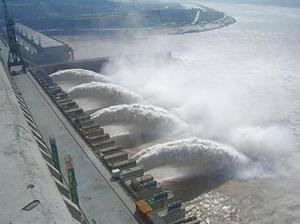Energy futuresHydropower gaining traction around the world
As more nations turn to renewable energy sources, wind and solar have often grabbed all the attention, but hydropower has been steadily making quiet gains. While hydroelectricity is becoming more prevalent, its future is riddled with uncertainty and difficult questions; in 2008, hydroelectricity generated more than 250 billion kilowatthours of electricity, roughly 67 percent of all renewable energy produced that year; new dam projects are also generating a lot of criticism from environmentalists and local residents who worry about the people who will be displaced as well as the dams’ environmental impacts; ironically hydroelectric dams will be affected by climate change, the very thing it is designed to combat

Mundane, effective and renewable power // Source: csanyigroup.com
As more nations turn to renewable energy sources, wind and solar have often grabbed all the attention, but hydropower has been steadily making quiet gains. While hydroelectricity is becoming more prevalent, its future is riddled with uncertainty and difficult questions.
According to Richard Taylor, the executive director of the International Hydropower Association, record amounts of hydropower capacity were added in 2008 and 2009. “There has been, over the last decade, a dramatic increase in the deployment of new hydropower capacity,” Taylor said.
In 2009, hydroelectricity projects accounted for 27 percent of all new renewable energy construction. While in 2008, hydroelectricity generated more than 250 billion kilowatthours of electricity, roughly 67 percent of all renewable energy produced that year.
Major dam projects are also popping up across the world including Brazil, Chile, and Laos in addition to the modernization of existing dams in Europe and the United States.
But, aside from electricity, these new dam projects are generating a lot of criticism from environmentalists and local residents who worry about the people who will be displaced as well as the dams’ environmental impacts.
Last week in Chile, people protested against a government plan to dam two rivers in a remote part of Patagonia. While last month, efforts to build a dam in Laos stalled, after government officials from Laos, Vietnam, Cambodia, and Thailand could not come to an agreement over the dam’s downstream implications.
The recent interest in hydro stems from the fact that it is arguably the most reliable and established source of renewable energy in the world.
Currently, hydroelectric projects account for 30 percent of new construction in the Clean Development Mechanism, which is part of an international plan to reduce emissions.
Ironically hydroelectric dams will be affected by climate change, the very thing it is designed to combat.
Fluctuations in rain or snowfall patterns can dramatically alter the amount of energy a dam produces as well as the amount of sediment flowing through a river.
The Intergovernmental Panel on Climate Change issued a summary report last week which found that climate change would have varying impacts across the world on hydroelectric projects.
“For hydropower the overall impacts on the global potential is expected to be slightly positive,” the report states. “However, results also indicate the possibility of substantial variations across regions and even within countries.”
Deborah Lynn Bleviss, a professor in the energy, resources and environment program at Johns Hopkins University’s School of Advanced International Studies, said prolonged droughts are negatively affecting dams across the world.
For instance, a decade ago Brazil experienced a bad drought which especially problematic as the country generates roughly 80 percent of its electricity from hydropower.
More recently a drought in 2009 hit Guatemala, Venezuela, Argentina and Uruguay, as well as Brazil.
“All have had impacts on hydropower capacity in these countries,” she said.
In China the Three Gorges Dam, the largest hydroelectric dam in the world, which sits on the Yangtze River, is currently suffering from a severe drought which has actually closed part of the river to shipping.
While some regions are receiving less rain and snow, others are receiving more.
In Norway, studies indicate that it will receive more rain and water which in turn will benefit hydropower plants.
Tor Arnt Johnsen, the head of the Norwegian Water Resources and Energy Directorate analysis division, said, “The studies have uncertain results, but the main result is that climate change on average will lead to more rain and thereby better production capability in Norwegian power plants.”
Innovative plans to harness hydroelectricity power’s potential and reduce its impact on the environment include using dams as a mechanism for flood control, refurbishing old dams by replacing old turbines to boost energy output, and “pumped storage” – using excess wind power at night to pump water uphill and then releasing it during the day when energy demand reaches its peak.
Although hydroelectric power is a renewable energy source, it emits more greenhouse gases than wind power. When dams are built, large areas covered with plants and trees are flooded and when they rot, they emit methane, a greenhouse gas more powerful than carbon dioxide.
As the world searches for renewable energy sources, hydroelectric energy is increasingly becoming an increasingly attractive option, but like all other forms of energy, it is accompanied with its own set of challenges.
